

Narragunnawali - Subject Guides. Science resource guide fffe8b3f4f. State Library of NSW. This mysterious portrait of an unknown, handsome young Aboriginal man is believed to have belonged to Governor Lachlan Macquarie.
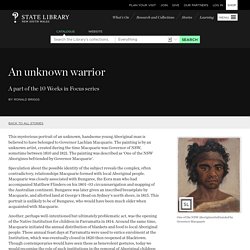
The painting is by an unknown artist, created during the time Macquarie was Governor of NSW, sometime between 1810 and 1821. The painting was described as ‘One of the NSW Aborigines befriended by Governor Macquarie’. Speculation about the possible identity of the subject reveals the complex, often contradictory, relationships Macquarie formed with local Aboriginal people. Macquarie was closely associated with Bungaree, the Eora man who had accompanied Matthew Flinders on his 1801–03 circumnavigation and mapping of the Australian continent.
Bungaree was later given an inscribed breastplate by Macquarie, and allotted land at George’s Head on Sydney’s north shore, in 1815. The first Indigenous cricket team to England. Indigenous Australians - Oral History and Sound Collections - Research Guides at State Library of New South Wales. D'harawal dreaming stories – 'Stories my mother told me' – Frances Bodkin. ANU School of Literature, Languages and Linguistics. In 1770 Captain James Cook was forced to beach the Endeavour for repairs near present-day Cooktown, after the ship had been damaged on reefs.
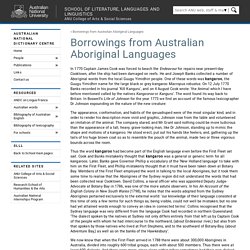
He and Joseph Banks collected a number of Aboriginal words from the local Guugu Yimidhirr people. One of these words was kangaroo, the Guugu Yimidhirr name for the large black or grey kangaroo Macropus robustus. On 12 July 1770 Banks recorded in his journal ‘Kill Kanguru’, and on 4 August Cook wrote: ‘the Animal which I have before mentioned called by the natives Kangooroo or Kanguru’.
The word found its way back to Britain. Indigenous Languages. DustEchoes-BatButterfly-StudyGuide. DustEchoes-MorningStar-StudyGuide. Aboriginal Uluru Dreamtime Story - Uluru (Ayers Rock) Australia. My Grandmother’s Lingo. Over the next 10 minutes, you'll speak one of the oldest languages in the world.
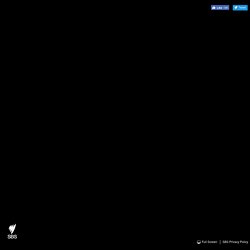
Each word you learn unlocks a new chapter. Put on your headphones and get your microphone ready. ...But... you're on a browser that doesn't let you use your microphone. Head to chrome or firefox to fully experience the story. The desktop version of this site detects how well you’re speaking the Marra language. Click 'allow' button in the browser prompt. Click 'share selected device' in the browser prompt. Looks like you have your mic blocked from being used on this page. We can't detect your microphone!
Eora - Mapping Aboriginal Sydney 1770-1850. Eora This is a story of the Eora, created through a close and innovative interrogation of the European records of early colonisation. Eora - Intro It is customary for some Indigenous communities not to mention names or reproduce images associated with the recently deceased. Members of these communities are respectfully advised that a number of people mentioned in writing or depicted in image in the following pages have passed away. This story may also contain words and descriptions that might be culturally sensitive, not normally used in certain public or community contexts. In some circumstances, terms and annotations of the period in which a text was written may be considered inappropriate today. Home - Barani. Importance of fire - National Geographic. Importance of land - National Geographic [Video]
Australian Sacred Sites. Australian Sacred Sites Aboriginal sacred sites are areas or places in Australia of significant Aboriginal Australian meaning within the animist context of the localised indigenous belief system.
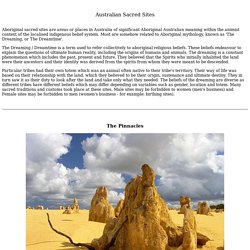
Most are somehow related to Aboriginal mythology, known as 'The Dreaming, or The Dreamtime'. The Dreaming / Dreamtime is a term used to refer collectively to aboriginal religious beliefs. These beliefs endeavour to explain the questions of ultimate human reality, including the origins of humans and animals. The dreaming is a constant phenomenon which includes the past, present and future. Particular tribes had their own totem which was an animal often native to their tribe's territory. The Pinnacles he Pinnacles are limestone formations contained within Nambung National Park, near the town of Cervantes, Western Australia. The cultural value of water. Aboriginal fish trap by Jacqui Badland“We (Aboriginal people) come from the land and we belong to the land” (Anonymous comment from ‘Feedback from Murray Lower Darling Rivers Indigenous Nations (MLDRIN) information session’ on the Basin Plan, Oct 2010, Murray Darling Basin Authority).

As the driest inhabited continent, the rivers of Australia have been the focal point of life for up to 60,000 years, playing an important role in Aboriginal social life and identity. By changing how, when, and where rivers flow, water resource development has affected the way Aboriginal communities interact with the landscape. Despite this, there is little Indigenous participation in water planning and management as well as limited capacity and understanding within water agencies about rights or values. The famous Aboriginal individuals of colonial Sydney Harbour. Bennelong the Wangal - Discovery. Living Black: S18 Ep9 - Bennelong. The Song of Bennelong and Pemulwuy. Significant Aboriginal people in Sydney - Barani. Portraits of Biddy Salamander of the Broken Bay Tribe, Bulkabra Chief of Botany, Gooseberry Queen of Bungaree, as depicted by Charles Rodius in 1834 (Mitchell Library, State Library of NSW - SAFE / PXA 615, Digital Order No. a1114010)
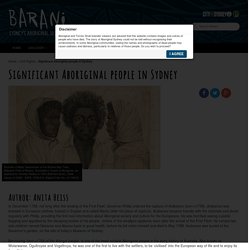
Australia Native Art and Aboriginal Paintings - Australia Native Art. Aboriginal cultural festivals - Creative Spirits. LAAL: Home. The many uses of indigenous plants - Science (4,7) 00:00:00:00Text on screen - 'Viewer Advice.

Aboriginal and Torres Strait Islander viewers are advised that the following media resource may contain images and voices of people who have died.' A group of Indigenous people distribute and plant native plants in Australian coastal bushland. Text on screen - 'The Towra Team. Clarence Slockee.'00:00:16:19CLARENCE SLOCKEE:These young people are called the Towra Team. They're a group of trainees learning to take care of the land and their culture here on the southern shore of Kamay Botany Bay National Park, about an hour south of Sydney.00:00:27:07A parks officer, Dean Kelly, gestures at the ground of a small clearing.00:00:27:07DEAN KELLY:Well, we might plant a couple of wattles here 'cause this one's struggling a little bit.00:00:33:03CLARENCE SLOCKEE:Dean Kelly is a parks officer and mentor for the group.00:00:36:14Dean Kelly is interviewed.
WilderQuest. Education - Policies and related issues on ASO - Australia's audio and visual heritage online. My Grandmother’s Lingo. National Museum of Australia. SBS: First Australians. Dust Echoes: Ancient Stories, New Voices. Famous Aboriginal people, activists & role models - Creative Spirits. Why we need Aboriginal role models Apart from obvious reasons like inspiration, setting an example, or showing what is possible, there's a more opaque reason we need Aboriginal role models: the media.
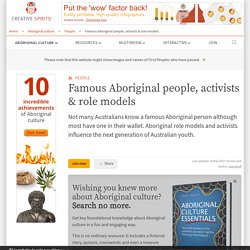
Journalists lack interest in reporting about Aboriginal achievers. "When you hear of some brilliant Indigenous person working in any of the professional sectors," says Jeff McMullen, a journalist himself, "the media turns away... The media needs to shift its message to an empowering one that gives individuals and families as a whole a sense of inclusiveness.” Read my tips for journalists. Who's missing? David Unaipon If you live in Australia, do you know that you're probably carrying a famous Aboriginal man in your wallet? Before the redesign in 2018, the 50-dollar note showed a couple standing in front of Raukkan Church.
David Unaipon fact file Cathy Freeman. The Buyungurra who didn't listen - English (F,4,6) Aboriginal history. Barani Barani is an Aboriginal word of the Sydney language that means 'yesterday'.

The Barani website examines the histories of people, places and events associated with Sydney's Aboriginal and Torres Strait Islander peoples. Visit Barani. WilderQuest. Aboriginal Australia without agenda - Creative Spirits. A History of Aboriginal Sydney. There is good evidence of a high Aboriginal population density at contact.
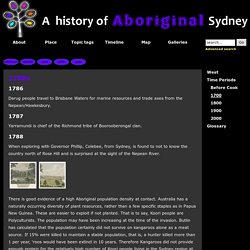
Australia has a naturally occurring diversity of plant resources, rather than a few specific staples as in Papua New Guinea. These are easier to exploit if not planted. That is to say, Koori people are Polyculturists. General - Aboriginal Education - The Department of Education. Aboriginal English & ESL Educational Resources Information Centre (ERIC)Free database of resources that may assist teachers with teaching ESL/D students. Details. Honouring Aboriginal ANZAC soldiers - ABC online education. ABC Online Indigenous - Interactive Map.
Indigenous Weather Knowledge - Bureau of Meteorology. Aboriginal and Torres Strait Islander people have developed an intricate understanding of the environment over many thousands of years. Artist: Laurie Nilsen The artwork used in the design of this website represents the relationships between seasonal, meteorological and astronomical changes - and how the Mandandanji people read these changes to inform life on country. About the Indigenous Weather Knowledge website Learn more about the Indigenous Weather Knowledge (IWK) website and the Bureau of Meteorology's commitment to strengthening respectful and collaborative relationships with Aboriginal and Torres Strait Islander people.
About the Indigenous Weather Knowledge website Language, culture and environmental knowledge See an overview of the relationships between language, culture and environmental knowledge. Language, culture and environmental knowledge Reconciliation Action Plan Download our RAP. About the Indigenous seasons calendars.